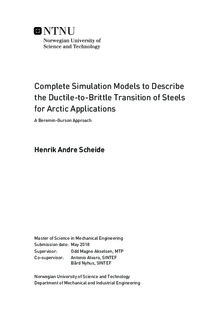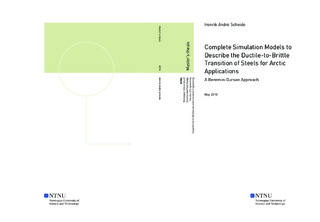| dc.description.abstract | The toughness of common structural steels is often affected by temperature changes where low service temperatures frequently promote brittle material characteristics. Low service temperatures often occur in the Arctic regions, and unexpected catastrophic failures may occur due to inadequate material characterisation. It is crucial to have a model with the highest level of accuracy to mitigate the risk of sudden brittle failure which in turn can precisely capture the material behaviour at shifting temperatures. The primary objective of the master s thesis is thus to develop a model which is able to describe the temperature dependence of fracture toughness in steels. The aim is to reduce the laboratory work needed to characterise the ductile-to-brittle transition regions. At lower temperatures, steels exhibit brittle behaviour and become susceptible to sudden brittle fracture without warning. Higher temperatures yield ductile behaviour with mechanisms such as void nucleation, void growth and void coalescence promoting ductile tearing and controlled ductile failure. The transition between the ductile and brittle regions exhibit both ductile and brittle behaviour and is crucial when steels are utilised in fluctuating and low service temperatures where sudden cleavage fracture may occur.
Two Gurson-RKR models are initially developed in a preliminary study to describe the complete ductile-to-brittle transition and to visualise the ductile, transition and brittle regions. The RKR Criterion is a post processing routine for the ductile Gurson model and is used to predict brittle failure by considering critical stresses along the crack ligament with the critical opening stress ahead of the crack tip as both temperature dependent and independent. The Combined Gurson-RKR Model with temperature independent opening stress can describe the ductile-to-brittle transition by demonstrating increasing fracture toughness with increasing temperature. However, the results are somewhat conservative as the combined model highly overestimates the steel s brittleness at higher temperatures. The Combined Gurson-RKR Model with temperature dependent critical opening stress can visualise the ductile-to-brittle regions where the upper and lower boundary limits capture all the experimental fracture toughness from -60°C to 21°C. Nevertheless, the opening stress temperature approximation cannot be concluded without further testing, and several material fitting parameters remain uncertain and questionable. Hence, further improvements of the current model is necessary in order to develop a sufficient model to describe the ductile-to-brittle transition of steels with limited laboratory testing.
Thus, a more comprehensive model is developed to describe the ductile-to-brittle transition by introducing a statistical and mechanisms based model following the weakest-link principle; instability of one single microcrack in an arbitrary volume element may lead to complete specimen failure. A Weibull-based criterion substitutes the distance-based RKR Criterion which in turn provides a framework for the connection between the driving forces on a micro-scale level and macro-scale models for cleavage fracture. The Weibull-based Beremin model is used as a post-processing routine combined with The Complete Gurson Model and constitutes a complete generalisation of the probability of brittle fracture and ductile damage control while concurrently accounting for and supporting different crack configurations, geometry constraints, and loading modes. The two Beremin model parameters fitted in the brittle region are calibrated from experimental and theoretical results and respectively characterises the flaw distribution and the scaling factor of the Weibull distribution utilised to calculate the probability of brittle fracture throughout the DBT.
The Weibull stress along with the calibrated Weibull parameters can be used to compute the probability of brittle failure by considering the aggregate sum of the maximum principal stresses in all the volume elements exceeding a particular critical stress. As the Beremin model largely underestimates the rupture energies in the transition region, The Complete Gurson Model is utilised to simulate ductile damage mechanisms to describe the shifting stress state in the transition region. The Weibull-based Beremin Model is then used as a post processing routine to calculate the probability of brittle failure concurrently with the competing ductile mechanisms integrated by The Complete Gurson Model. Hence, the Gurson model is independently fitted to the experimental results at the highest temperature in the ductile region to accurately describe ductile mechanisms and crack extension throughout the ductile-to-brittle transition. The Gurson model can simulate accurate crack extension throughout the DBT for the high constraint geometry when utilising temperature independent Gurson parameters. However, the same Gurson parameters are only to some extent able to characterise the applicable resistance curves for the low constraint geometry.
The Weibull-based Beremin model can constraint-correct and characterise the fracture toughness to the specimens in the brittle region but is only to some extent able to describe the DBT as it overestimates the steel s brittleness in the transition region. A Gurson user-defined material (UMAT) with constitutive ductile mechanism equations is then used to characterise typical material behaviour in the transition region. The Beremin-Gurson model with temperature independent Weibull parameters fitted at the lowest temperature in the brittle region can constraint-correct the fracture geometries and describe the fracture toughness throughout the brittle region. However, the model is unable to capture the lower bound transition at higher temperatures but can capture the applicable upper bound transition in the ductile-to-brittle transition which evidently supports temperature dependent Weibull parameters. Thus, toughness scaling and constraint-correction of two fracture geometries with different constraint levels are conducted to find the appropriate temperature dependent Weibull parameters. The Beremin-Gurson model with temperature dependent Weibull parameters can accurately constraint-correct the fracture geometries and describe the relevant fracture toughness values throughout the ductile-to-brittle transition. The Weibull modulus defining the flaw distribution and the slope of the Weibull cumulative distribution function is constant in the brittle region and increases when entering the transition region where it remains relatively constant throughout the transition region. The scale parameter defining the resistance to brittle failure follows the opposite trend as large Weibull modulus promote small scale parameters and vice versa.
The current Beremin-Gurson model needs further improvements as several material parameters remain questionable and uncertain. The Weibull stress calculation program LINKpfat must be further enhanced to represent the weakest-link principles in the constitutive Beremin model. Thus, a thorough evaluation of the Weibull stress calculation is necessary. Another weld simulated steel must be evaluated to conclude the Weibull parameter temperature trends, and a third constraint level must be integrated to infer the accuracy of the constraint-correction. | |

